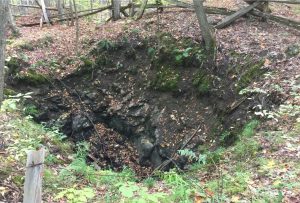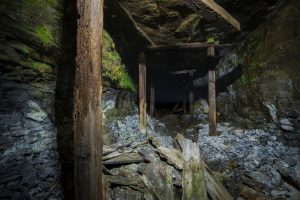Mining is a massive force of the Ontario economy, employing 75,000 people and generating over $10 billion in revenue annually. Ontario is the largest producer of gold, platinum, and nickel in the country; mining also produces large amounts of salt and materials for high-tech equipment. On the other side of these major benefits to Ontario is the lingering problem of over 5,000 abandoned mines requiring renewed government and industry focus.
Long thought of as a backbone of the provincial economy, regulation was sparse in the early decades of Ontario’s settlement. People knew the ground held fertile minerals underneath, but long-term environmental thinking was not a factor then. “A lot of the mines were very small companies, or they might have been family run businesses. Especially the very small mines. Once they got what they wanted, they just left. There were no regulations like there are today,” explains OSPE Board Director and mineral industry expert Sue Tessier, P.Eng.
Since 1991, the regulations around mine closures have tightened considerably. Before any mine can be opened in Ontario, it must present closure plans that take environmental considerations into account. However, the large number of pre-1991 mines abandoned continue to cause environmental damage.

Mines were opened and discarded in a simple manner. “Somebody gets the right to put a well on a property and they get what they can, or they run out of money, whatever happens. The infrastructure just kind of gets left there.” As environmental science and awareness progressed, it became apparent that these abandoned mines were silently damaging the land. It would be a complex and expensive mission to fix them.
“Especially with gold mines, the processing was with cyanide. That cyanide is still trapped in the tailings that were disposed of on the land,” and continue to seep into the ground in unpredictable ways. Beyond this is the long-term damage caused by leaking arsenic, as is occurring in Sudbury, where it seeps into Long Lake. The damage is significant enough that local residents are forced to turn to bottled water. Then there is the simple danger of their design, as they are often no more than gaping holes in the ground left unsupervised or patrolled.
The Kam Kotia project, near Timmins, Ontario, is considered one of the largest ecological rehabilitation attempts in the province, costing roughly $75 million. The former gold mine in Sudbury, that still leaks arsenic into Long Lake, brought its owners $63 million in wealth, but the cost of its closing and fixing has been left to taxpayers. The mine was closed in 1939—almost 100 years later, its total cost to the environment has still not been tabulated.
Mark Frayne, P.Eng., an OSPE Board Director with 30 years of experience in the mining industry, believes that there are multiple ways to approach the problem. There are many solutions that involve reinvigorating the use of mines. For one, the bat population loves abandoned mines. “A lot of older mines have basically horizontal entrances. They’re restoring those to benefit the bat population. Enough for bats to get in and have a home.” American data shows that 95% of bats in Wisconsin use abandoned mines for hibernation, and 13 of Colorado’s 17 bat populations use abandoned mines, including endangered bat species. Considering the long history of environmental degradation caused by loose regulation around mines, this example of environmental reclamation shows how the abandoned mines still have plenty of worth.

New technology has also extended the life of abandoned mines. “The best place to find ore is at or around an operating mine or an old mine. A lot of the prospecting is around some of these old, abandoned mines, looking for extensions to the ore body. Or even lower grade ore now because we can extract it so much cheaper” Frayne explains. The economic benefit of restoring or rehabilitating abandoned mines is found not only in their extension, but as the Kam Kotia project proves, the massive influx of money it can bring to an area.
The economic benefit of restoring the mines safely has the potential of involving local communities. Currently, the mining industry stands as one of the largest private sector employers of members from the Indigenous community. Gary Pritchard, a Senior Aquatic Ecologist and Manager of Environment and Climate change at Cambium Aboriginal, hopes that any ongoing or new relationship with the abandoned mines considers First Nations rights, obligations, and considerations to the land and community.
“Canadians always say, ‘we all need jobs.’ That is true—I’m not against mining—more thought needs to be put into it. The old way of mining isn’t the way of the future. Usually jobs First Nations receive are manual labour. No one can receive a higher status job, or be a fundamental stakeholder in the process. Part of me believes there’s a lot of tokenism, ‘Oh we tried, too bad.’”
Pritchard envisions an agreement that enforces a mutual sharing of resources as an important step for Canada, noting that, “Early treaties depicted that [resource sharing]—but those obligations were never fulfilled. What I would like to see is more of a lucrative agreement where they [First Nations communities] receive a profit of the mine. A meaningful percentage of what the cost of doing business is, so they can overcome the structural challenges in the community.”
Prioritizing Indigenous values does not only mean economic concerns, but environmental issues, alleviating the problems caused by previously abandoned mines. “You’re taking something that’s inherently mine. Every time there’s a mine, there’s an impact on Indigenous rights. Certain mine sites will limit access; or animals for habitats—we can’t access those animals to feed our family. The impacts of water, air quality. Environmental monitoring is worth the cost to open a mine.”

Of course, as Pritchard stresses, any economic focus on resource sharing, and ensuring that First Nations see a benefit from use of their land, is positive for everyone, “I do see that if it was done correctly, it would be mutually beneficial to both sides of Canada.” Prichard’s mutually beneficial view of restoring abandoned mines is a vision that fulfills Canada’s obligation to its First Nation communities, protects the environment, and grows the economy.
Looking at the entire region, OSPE President Rejeanne Aimey, P. Eng, concurrs and notes its vitality. “Ontario’s Ring of Fire can meet Canada’s resource needs sustainably using innovative mining technologies while maximizing jobs for engineers and the needs of the local indigenous workforce. This is an asset that if managed effectively can assist in Ontario’s long-term economic recovery now, and well beyond COVID-19.”
Safety, Indigenous concerns, and the economic and environmental ramifications for all Ontarians, must be prioritized by the Ontario government in conjunction with the Federal government to establish and fulfill the obligations outlined in the Canadian Minerals and Metals Plan. OSPE, in conversation with its task-force members has compiled evidence-based recommendations for the government to consider. “We believe that these sound policy recommendations will strengthen the community, environment, and economy. Although we’ve made these recommendations to the Federal and Provincial governments, I don’t believe they fully understand the risk to health and to the environment of these affected communities”, according to Sandro Perruzza, CEO of OSPE. The government and mining industry has a unique opportunity to Lead, Care, and Unite, for a stronger, engineer-lead future.






Closing the mines properly is very expensive, which is why all the abandoned mines have become a problem for Ontario. The government should pay attention before force majeure happens.